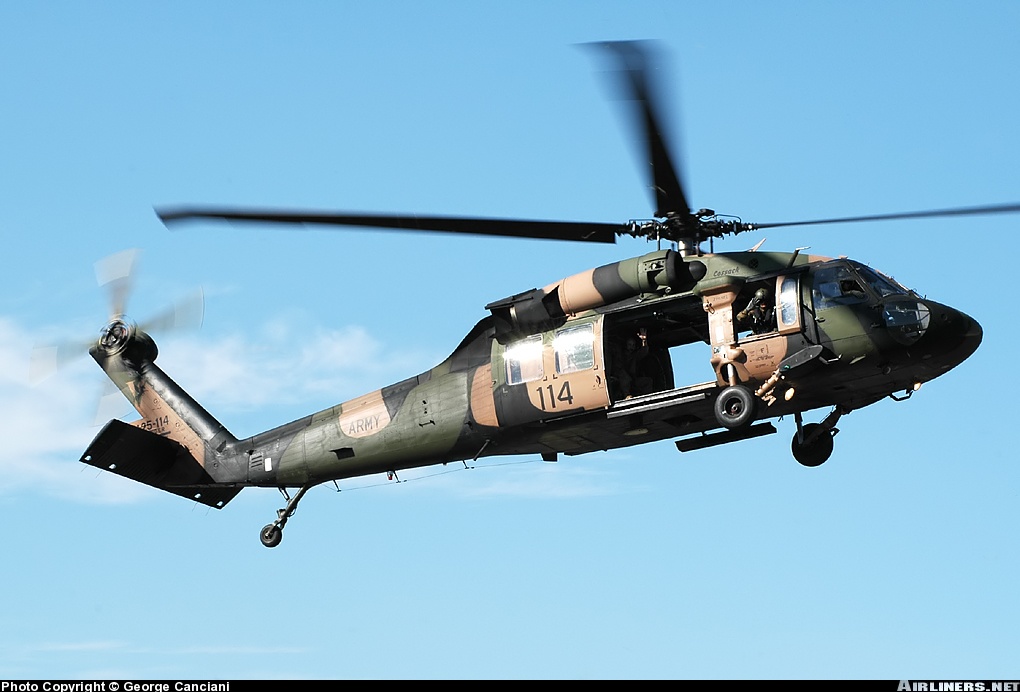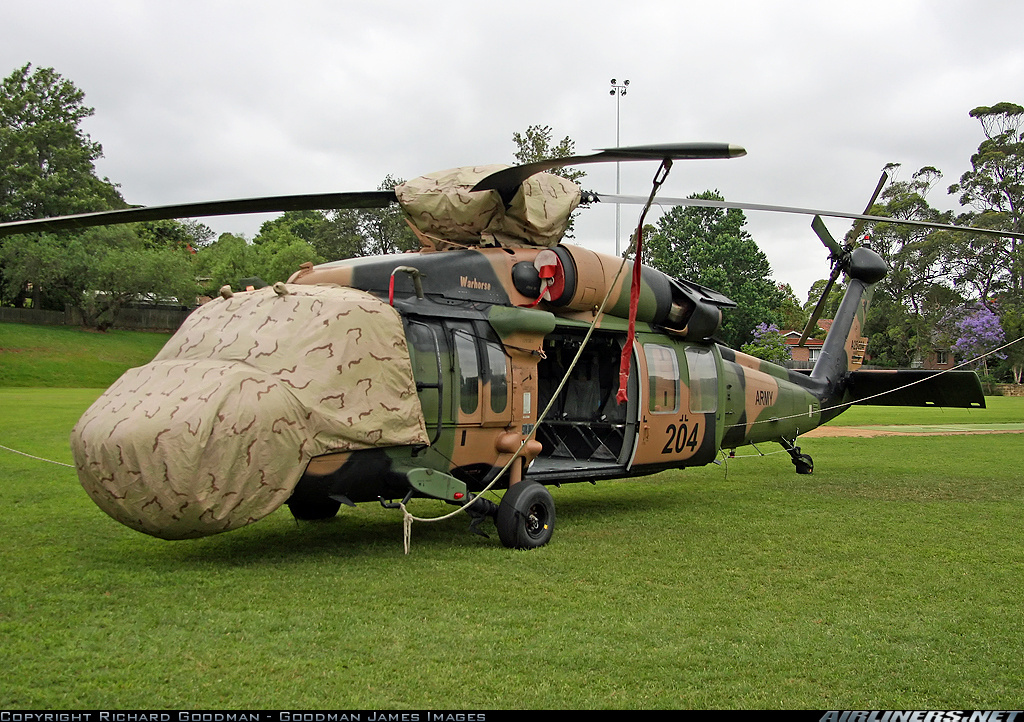Sikorsky (Hawker de Havilland) S70A9 Black Hawk Australia Army Aviation Photo 1748948

Sikorsky (Hawker de Havilland) S70A9 Black Hawk Australia Army Aviation Photo 1524273
The de Havilland company became a member of the Hawker Siddeley group in 1960, but lost its separate identity in 1963. Later, Hawker Siddeley merged into what is eventually known today as BAE Systems, the British aerospace and defence business.

Sikorsky (Hawker de Havilland) S70A9 Black Hawk Australia Army Aviation Photo 1751321
The de Havilland Vampire is a British jet fighter which was developed and manufactured by the de Havilland Aircraft Company. It was the second jet fighter to be operated by the RAF, after the Gloster Meteor, and the first to be powered by a single jet engine .

Sikorsky (Hawker de Havilland) S70A9 Black Hawk Australia Army Aviation Photo 0692137
De Havilland Aircraft was merged with Hawker Siddeley in 1959, although it was not until 1963 that the Australian company name was changed to Hawker De Havilland (HdH) in 1965. During the remainder of the 1960s it carried out support and repair work on a number of manufacturer's aircraft as well as manufacturing wings and control surfaces.

Sikorsky (Hawker de Havilland) S70A9 Black Hawk Australia Army Aviation Photo 0707769
One of the first and most successful executive jets. The 125 is one of a unique group of aircraft that can be claimed by up to 5 different manufacturers (De Havilland, Hawker Siddeley, British Aerospace, Raytheon and Hawker Beechcraft) all having played a role in its development.

Sikorsky (Hawker de Havilland) S70A9 Black Hawk Australia Army Aviation Photo 1748948
In all, Hawker Siddeley built just 117 Tridents and few aviation historians deny that the groundwork de Havilland laid with its 121 st design should have been the springboard for huge global.

Sikorsky (Hawker de Havilland) S70A9 Black Hawk Australia Army Aviation Photo 0622541
By 1960 de Havilland had been acquired by the Hawker Siddeley Group, the forerunner to British Aerospace. Now called the "Trident 1E" the plane entered service with BEA on April 1, 1964. Realizing that its routes were expanding further, BEA asked Hawker Siddeley if they could manufacture a Trident with more extended range capabilities..

Sikorsky (Hawker de Havilland) S70A9 Black Hawk Australia Army Aviation Photo 2410576
Hawker Siddeley was a group of British manufacturing companies engaged in aircraft production. Hawker Siddeley combined the legacies of several British aircraft manufacturers, emerging through a series of mergers and acquisitions as one of only two such major British companies in the 1960s.

Sikorsky (Hawker de Havilland) S70A9 Black Hawk Australia Army Aviation Photo 2028982
Almost 95 years ago, in 1928, De Havilland Canada was founded as a subsidiary of UK planemaker De Havilland Aircraft. Since then, the company and its aircraft designs have gone from government ownership to being under the control of Boeing, and then on to Bombardier. Now, in 2022, the parent company owning the Type Certificates of De Havilland.

Sikorsky (Hawker de Havilland) S70A9 Black Hawk Australia Army Aviation Photo 1764273
Following the absorption of de Havilland by Hawker Siddeley, DHA was renamed Hawker de Havilland (HdH) in 1965. In 1959 the de havilland marine division was formed.

De Havilland DH.51, VPKAA / 102, Hawker Siddeley Aviation ABPic
It became Hawker de Havilland Australia in 1961 and acquired the former Commonwealth Aircraft Corporation in 1986. In late 2000, following the acquisition of Hawker de Havilland by The Boeing Company, it was merged with the already owned AeroSpace Technologies of Australia.

Sikorsky (Hawker de Havilland) S70A9 Black Hawk Australia Army Aviation Photo 1533489
The Nimrod was itself a heavily modified version of the de Havilland Comet, an airplane that holds a special distinction as the world's first commercial jet airliner.At the time of its creation.

Sikorsky (Hawker de Havilland) S70A9 Black Hawk Australia Army Aviation Photo 2802597
Hawker de Havilland, a Boeing subsidiary and 787 supplier, embraces new tools and processes to link teammates worldwide. BY MARIBETH BRUNO. The collection of World War II-era buildings that make up the Hawker de Havilland facility in Melbourne, Australia, belie the fact that there's cutting-edge research and manufacturing going on inside..

Sikorsky (Hawker de Havilland) S70A9 Black Hawk Australia Army Aviation Photo 1196138
On the 100th anniversary of de Havilland, Key Aero examines the history of the DH.121 - later the Hawker Siddeley HS-121 Trident - which was the Hatfield-based airframer's final airliner design before its merger in 1960.. Hawker Siddeley, which had merged with de Havilland in 1960, wanted additional customers for the type, so entered.

Sikorsky (Hawker de Havilland) S70A9 Black Hawk Australia Army Aviation Photo 0295114
With Airco now out of business, Geoffrey de Havilland (alongside the rest of the Airco employees) were now out of a job. Smelling an opportunity, Geoffrey reached out to George Thomas Holt - his former boss and owner of Airco.

Sikorsky (Hawker de Havilland) S70A9 Black Hawk Australia Army Aviation Photo 1839548
This is a list of aircraft produced or proposed by Geoffrey de Havilland or designed at the de Havilland Aircraft Company from its founding in 1920 until its purchase by (and integration into) the Hawker Siddeley Group in 1959.

Sikorsky (Hawker de Havilland) S70A9 Black Hawk Australia Army Aviation Photo 1722505
This was originally developed as the DH.121, but by the time it entered service, de Havilland had become part of Hawker Siddeley. The Trident was a trijet narrowbody aircraft that first flew in 1962. It was the first three-engined commercial jet to fly and a British-built competitor to the Boeing 727. Overall, 117 aircraft were delivered to UK.